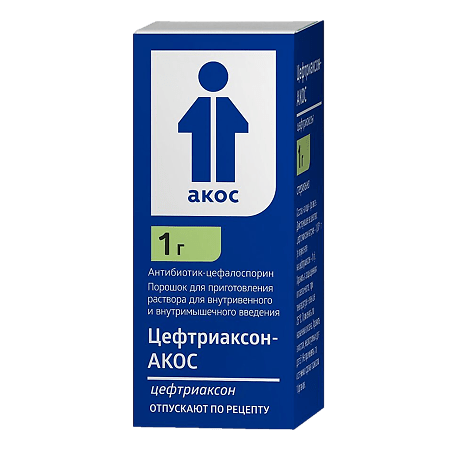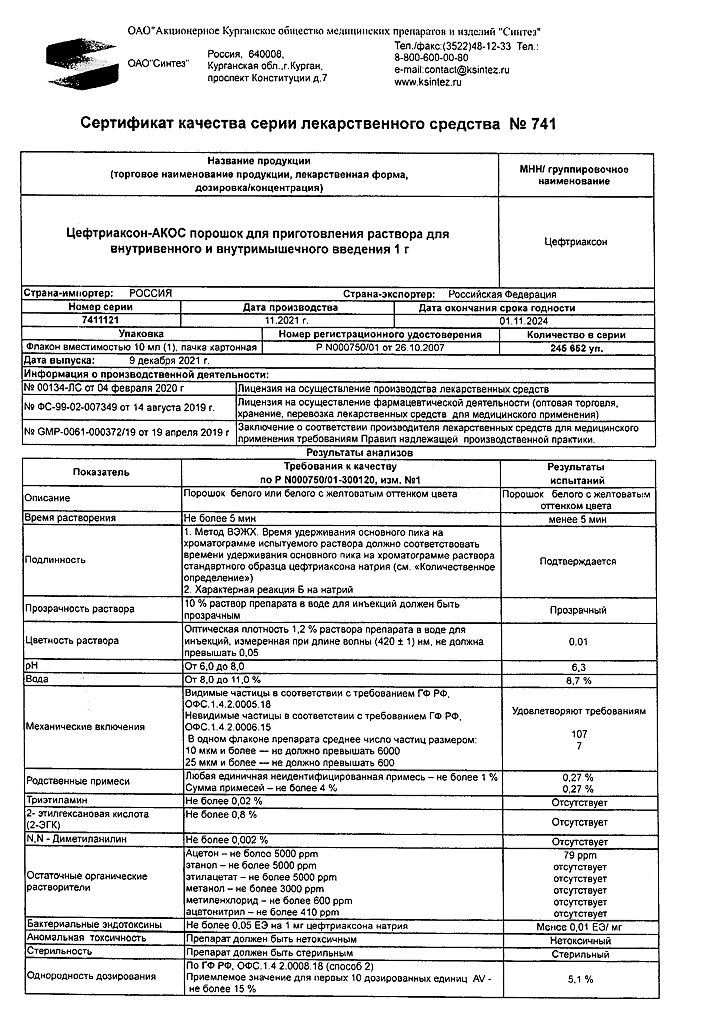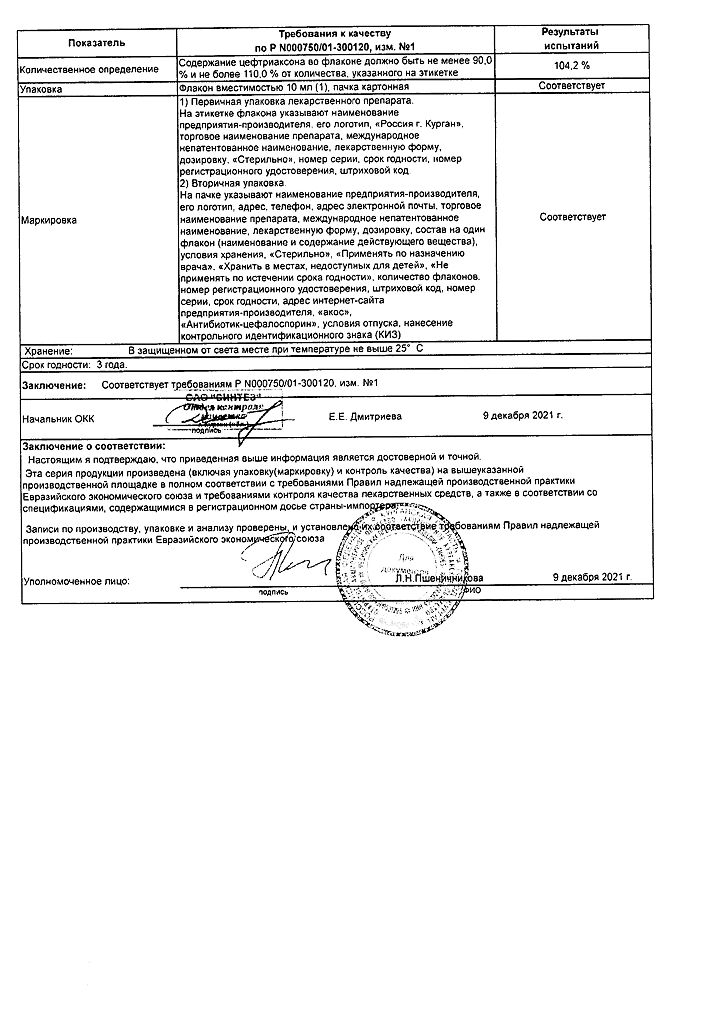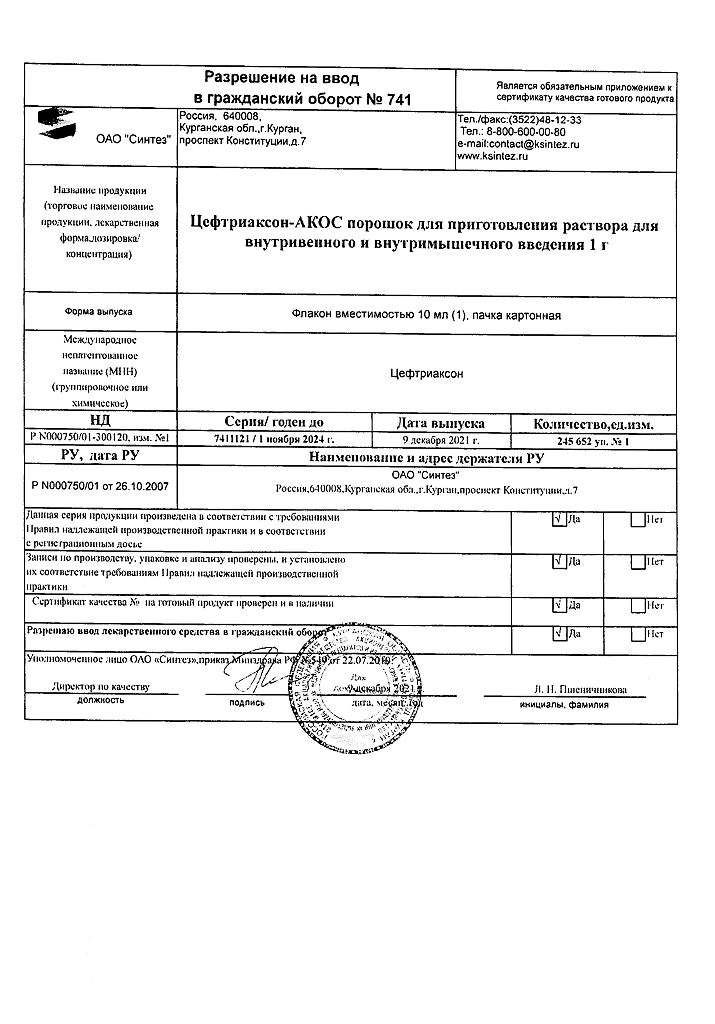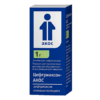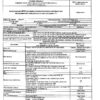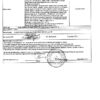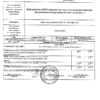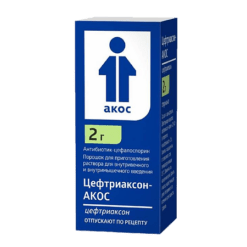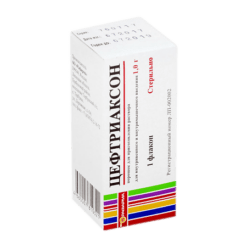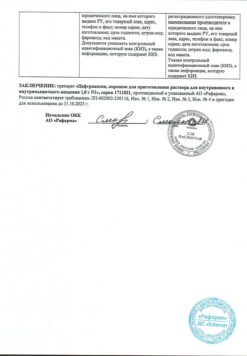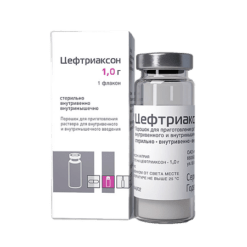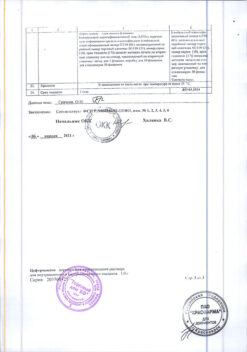No products in the cart.
Description
Pharmacotherapeutic group
Cephalosporin antibiotic
ATX code: J01DD04
Pharmacodynamics
Ceftriaxone is a broad-spectrum III generation cephalosporin antibiotic for parenteral administration. Bactericidal activity is due to inhibition of cell wall synthesis. In vitro it has a broad spectrum of action against Gram-negative and Gram-positive microorganisms. It is characterized by high resistance to action of most beta-lactamases (both penicillinases and cephalosporinases) produced by Gram-positive and Gram-negative bacteria.
Ceftriaxone is generally active against the following microorganisms:
Gram-positive aerobes: Staphylococcus aureus (methicillin-sensitive), coagulase-negative staphylococci, Streptococcus pyogenes (beta-hemolytic, group A), Streptococcus agalactiae (beta-hemolytic, group B), beta-hemolytic streptococci (neither group A nor B), Streptococcus viridans, Streptococcus pneumoniae.
Note: Methicillin-resistant Staphylococcus spp. are resistant to cephalosporins, including ceftriaxone. Enterococcus faecalis, Enterococcus faecium and Listeria monocytogenes are also generally resistant.
Gram-negative aerobes: Acinetobacter lwoffii, Acinetobacter anitratus (mainly A. baumannii)*; Aeromonas hydrophila, Alcaligenes faecalis, Alcaligenes odorans, alkaligenes-like bacteria, Borrelia burgdorferi, Capnocytophaga spp, Citrobacter diversus (including C. amalonaticus), Citrobacter freundii*, Enterobacter aerogenes*, Enterobacter cloacae*, Enterobacter spp. (other)*, Escherichia coli, Haemophilus ducreyi, Haemophilus influenzae, Haemophilus parainfluenzae, Hafnia alvei, Klebsiella oxytoca, Klebsiella pneumoniae**, Moraxella catarrhalis (previously called Branhamella catarrhalis), Moraxella osloensis, Moraxella spp. (others), Morganella morganii, Neisseria gonorrhoeae, Neisseria meningitidis, Pasteurella multocida, Plesiomonas shigelloides, Proteus mirabilis, Proteus penneri*, Proteus vulgaris*, Pseudomonas fluorescens*, Pseudomonas spp. (other), Providencia rettgeri*, Providencia spp. (other), Salmonella typhi, Salmonella spp. (nontyphoid), Serratia spp. (other)*, Serratia marcescens*, Shigella spp, Vibrio spp., Yersinia enterocolitica, Yersinia spp. (other).
* – Some isolates of these species are resistant to ceftriaxone, mainly due to the formation of beta-lactamases encoded by chromosomes.
** – Some isolates of these species are resistant due to the formation of a variety of plasmid-mediated beta-lactamases.
Note: Many strains of the above microorganisms that are multiresistant to other antibacterial drugs, such as aminopenicillins and ureidopenicillins, first and second generation cephalosporins, aminoglycosides, are sensitive to ceftriaxone. Treponema pallidum is sensitive to ceftriaxone in vitro and in animal experiments. Clinical studies have shown that ceftriaxone has good efficacy against primary and secondary syphilis. With very few exceptions, clinical isolates of Pseudomonas aeruginosa are resistant to ceftriaxone.
Anaerobes: Bacteroides spp. (biliary sensitive)*, Clostridium spp. (except Clostridium difficile), Fusobacterium nucleatum, Fusobacterium spp. (other), Gaffkya anaerobica (previously called Peptococcus), Peptostreptococcus spp.
* – Some isolates of these species are resistant to ceftriaxone because of betalactamase formation‑.
Note: Many strains of beta-lactamase-producing Bacteroides spp. (particularly B. fragilis) are resistant. Clostridium difficile is also resistant.
Ceftriaxone discs should be taken for determination because in vitro studies have shown that ceftriaxone is active against individual strains that show resistance when discs designed for the entire group of cephalosporins are used.
In lieu of ICLS standards, other well-standardized standards such as those of the German Institute for Standardization DIN (Deutsches Institut fur Normung) and the International Collaborative Study (ICS) recommendations ‑can be used to adequately interpret the sus‑ceptibility status of ‑microorganisms.
Pharmacokinetics
The pharmacokinetics of ceftriaxone is nonlinear. All major pharmacokinetic parameters based on total drug concentrations, with the exception of the elimination half-life, are dose-dependent and increase in less than proportional proportion to its increase. Non-linearity is typical for pharmacokinetic parameters that depend on the total concentration of ceftriaxone in blood plasma (not only free ceftriaxone), and is explained by saturation of the drug binding to blood plasma proteins. After intravenous infusion of 500 mg, 1 g, and 2 g of ceftriaxone, plasma concentrations of the drug were approximately 80, 150, and 250 mg/L, respectively.
Distribution
The volume of distribution of ceftriaxone is 7-12 liters. After administration in a dose of 1-2 g ceftriaxone penetrates well into tissues and body fluids. For more than 24 hours, its concentrations far exceed the minimum suppressive concentrations for most infectious agents in more than 60 tissues and fluids (including the lungs, heart, biliary tract, liver, tonsils, middle ear and nasal mucosa, bones, as well as cerebrospinal, pleural and synovial fluid and prostate secretion). After intravenous administration ceftriaxone quickly penetrates into the cerebrospinal fluid, where bactericidal concentrations against sensitive microorganisms persist for 24 hours.
Protein binding
Ceftriaxone binds reversibly to albumin. The degree of binding is approximately 95% when values of ceftriaxone concentration in blood plasma are less than 100 mg/l. The proportion of ceftriaxone bound to plasma protein decreases with increasing concentration, as the binding is saturable and is about 85% at values of 300 mg/l.
Perfusion to selected tissues
Ceftriaxone penetrates through the cerebral membranes, but to the greatest extent in their inflammation. The average maximum concentration of ceftriaxone in the cerebrospinal fluid reaches 25% of the plasma ceftriaxone concentration in patients with bacterial meningitis, and only 2% of the plasma ceftriaxone concentration in patients with non-inflamed cerebral membranes. The maximum concentration of ceftriaxone in the cerebrospinal fluid is reached 4-6 hours after its intravenous administration. Ceftriaxone passes through the placental barrier and passes in low concentrations into breast milk.
Metabolism
Ceftriaxone does not undergo systemic metabolism but is converted into inactive metabolites by the intestinal microflora.
The total plasma clearance of ceftriaxone is 10-22 ml/min. Renal clearance is 5-12 ml/min. 50-60% of ceftriaxone is excreted unchanged by the kidneys, and 40-50% – unchanged by the intestine. The half-life of ceftriaxone in adults is about 8 hours.
Pharmacokinetics in special clinical cases
In newborns, infants and children younger than 12 years
In newborn children the half-life of ceftriaxone is longer compared to other age groups. During the first 14 days of life, the plasma concentration of free ceftriaxone may be further increased due to low glomerular filtration and the features of the drug binding to blood plasma proteins. In pediatric patients the half-life is shorter than in newborns and adults.
The values of plasma clearance and volume of distribution of total ceftriaxone are higher in neonates, infants and children younger than 12 years compared to those in adults.
Hepatic or renal impairment
In patients with impaired renal or hepatic function, the pharmacokinetics of ceftriaxone do not change significantly, with only a slight increase in half-life (less than 2-fold) even in patients with severe renal impairment. Slight increase of ceftriaxone half-life in renal failure can be explained by compensatory increase of nonrenal clearance as a result of decrease of plasma protein binding degree and corresponding increase of nonrenal clearance of total ceftriaxone.
In patients with hepatic insufficiency the half-life is not increased. In these patients there is a compensatory increase in renal clearance. This is also due to an increase in the plasma concentration of free ceftriaxone, which contributes to a paradoxical increase in total drug clearance against an increase in the volume of distribution.
Patients of advanced age
In patients over 75 years of age, the half-life is, on average, two to three times longer than in adult patients.
Indications
Indications
Infections caused by pathogens sensitive to ceftriaxone: sepsis; meningitis; disseminated Lyme disease (stages II and III of the disease); infections of the abdominal organs (peritonitis, infections of the biliary tract and gastrointestinal tract); infections of bones, joints, soft tissues, skin, as well as wound infections; infections in immunocompromised patients; kidney and urinary tract infections; respiratory tract infections, especially pneumonia, and ENT infections; genital infections.
Perioperative infection prevention.
Pharmacological effect
Pharmacological effect
Pharmacotherapeutic group
Antibiotic-cephalosporin
ATX code: J01DD04
Pharmacodynamics
Ceftriaxone is a third-generation broad-spectrum cephalosporin antibiotic for parenteral administration. Bactericidal activity is due to suppression of cell wall synthesis. In vitro it has a wide spectrum of action against gram-negative and gram-positive microorganisms. It is highly resistant to the action of most beta-lactamases (both penicillinases and cephalosporinases) produced by gram-positive and gram-negative bacteria.
Ceftriaxone is usually active against the following microorganisms:
Gram-positive aerobes: Staphylococcus aureus (methicillin-sensitive), coagulase-negative staphylococci, Streptococcus pyogenes (beta-hemolytic, group A), Streptococcus agalactiae (beta-hemolytic, group B), beta-hemolytic streptococci (neither A nor B groups), Streptococcus viridans, Streptococcus pneumoniae.
Note: Methicillin-resistant Staphylococcus spp. resistant to cephalosporins, including ceftriaxone. In general, Enterococcus faecalis, Enterococcus faecium and Listeria monocytogenes are also resistant.
Gram-negative aerobes: Acinetobacter lwoffii, Acinetobacter anitratus (mainly A. baumannii)*; Aeromonas hydrophila, Alcaligenes faecalis, Alcaligenes odorans, alkaligen-like bacteria, Borrelia burgdorferi, Capnocytophaga spp., Citrobacter diversus (including C. amalonaticus), Citrobacter freundii*, Enterobacter aerogenes*, Enterobacter cloacae*, Enterobacter spp. (other)*, Escherichia coli, Haemophilus ducreyi, Haemophilus influenzae, Haemophilus parainfluenzae, Hafnia alvei, Klebsiella oxytoca, Klebsiella pneumoniae**, Moraxella catarrhalis (formerly called Branhamella catarrhalis), Moraxella osloensis, Moraxella spp. (others), Morganella morganii, Neisseria gonorrhoeae, Neisseria meningitidis, Pasteurella multocida, Plesiomonas shigelloides, Proteus mirabilis, Proteus penneri*, Proteus vulgaris*, Pseudomonas fluorescens*, Pseudomonas spp. (others), Providencia rettgeri*, Providencia spp. (other), Salmonella typhi, Salmonella spp. (non-typhoid), Serratia spp. (others)*, Serratia marcescens*, Shigella spp., Vibrio spp., Yersinia enterocolitica, Yersinia spp. (others).
* – Some isolates of these species are resistant to ceftriaxone, mainly due to the formation of chromosomally encoded beta-lactamases.
** — Some isolates of these species are resistant due to the formation of a number of plasmid-mediated beta-lactamases.
Note: Many strains of the above microorganisms, multiresistant to other antibacterial drugs, such as aminopenicillins and ureidopenicillins, cephalosporins of the first and second generations, aminoglycosides, are sensitive to ceftriaxone. Treponema pallidum is sensitive to ceftriaxone in vitro and in animal experiments. Clinical studies have shown that ceftriaxone has good efficacy against primary and secondary syphilis. With very few exceptions, clinical isolates of Pseudomonas aeruginosa are resistant to ceftriaxone.
Anaerobes: Bacteroides spp. (bile-sensitive)*, Clostridium spp. (except Clostridium difficile), Fusobacterium nucleatum, Fusobacterium spp. (others), Gaffkya anaerobica (formerly called Peptococcus), Peptostreptococcus spp.
* – Some isolates of these species are resistant to ceftriaxone due to the formation of beta-lactamases.
Note: Many strains of beta-lactamase-producing Bacteroides spp. (in particular B. fragilis) are resistant. Clostridium difficile is also resistant.
For determination, discs with ceftriaxone should be taken, since in vitro studies have shown that ceftriaxone is active against certain strains that show resistance when using discs intended for the entire group of cephalosporins.
Instead of ICLS standards, other well-standardized standards can be used to determine the sensitivity of microorganisms, for example, the German Institute for Standardization DIN (Deutsches Institut fur Normung) and the international recommendations of ICS (International Collaborative Study), which allow adequate interpretation of the state of sensitivity.
Pharmacokinetics
The pharmacokinetics of ceftriaxone is nonlinear. All major pharmacokinetic parameters based on total drug concentrations, with the exception of half-life, are dose dependent and increase less than dose proportionally. Nonlinearity is characteristic of pharmacokinetic parameters that depend on the total concentration of ceftriaxone in the blood plasma (not only free ceftriaxone) and is explained by the saturation of the binding of the drug to plasma proteins. Following intravenous infusion of 500 mg, 1 g, and 2 g of ceftriaxone, plasma drug concentrations were approximately 80, 150, and 250 mg/L, respectively.
Distribution
The volume of distribution of ceftriaxone is 7–12 liters. After administration in a dose of 1–2 g, ceftriaxone penetrates well into body tissues and fluids. Over a period of more than 24 hours, its concentrations far exceed the minimum inhibitory concentrations for most infectious agents in more than 60 tissues and fluids (including the lungs, heart, biliary tract, liver, tonsils, middle ear and nasal mucosa, bones, as well as cerebrospinal, pleural and synovial fluids and prostate secretions). After intravenous administration, ceftriaxone quickly penetrates into the cerebrospinal fluid, where bactericidal concentrations against sensitive microorganisms are maintained for 24 hours.
Protein binding
Ceftriaxone binds reversibly to albumin. The degree of binding is approximately 95% at ceftriaxone plasma concentrations less than 100 mg/l. The proportion of ceftriaxone bound to blood plasma protein decreases with increasing its concentration, since binding is saturable and is about 85% at concentration values of 300 mg/l.
Penetration into individual tissues
Ceftriaxone penetrates the meninges, but to the greatest extent when they are inflamed. The mean maximum concentration of ceftriaxone in the cerebrospinal fluid reaches 25% of the plasma concentration of ceftriaxone in patients with bacterial meningitis, and only 2% of the plasma concentration of ceftriaxone in patients with non-inflamed meninges. The maximum concentration of ceftriaxone in the cerebrospinal fluid is achieved 4–6 hours after its intravenous administration. Ceftriaxone passes through the placental barrier and enters breast milk in low concentrations.
Metabolism
Ceftriaxone does not undergo systemic metabolism, but is converted into inactive metabolites under the influence of intestinal microflora.
Removal
The total plasma clearance of ceftriaxone is 10–22 ml/min. Renal clearance is 5–12 ml/min. 50–60% of ceftriaxone is excreted unchanged by the kidneys, and 40–50% is excreted unchanged by the intestines. The half-life of ceftriaxone is approximately 8 hours in adults.
Pharmacokinetics in special clinical situations
Newborns, infants and children under 12 years of age
In newborns, the half-life of ceftriaxone is increased compared to other age groups. In the first 14 days of life, the concentration of free ceftriaxone in the blood plasma can be further increased due to low glomerular filtration and the peculiarities of the drug binding to plasma proteins. In pediatric patients, the half-life is shorter than in neonates and adults.
The values of plasma clearance and volume of distribution of total ceftriaxone are higher in newborns, infants and children under 12 years of age compared to those in adults.
Impaired kidney or liver function
In patients with impaired renal or hepatic function, the pharmacokinetics of ceftriaxone changes slightly, with only a slight increase in the half-life (less than 2-fold) even in patients with severe renal impairment. The slight increase in the half-life of ceftriaxone in renal failure may be explained by a compensatory increase in non-renal clearance as a result of a decrease in the degree of binding to plasma proteins and a corresponding increase in non-renal clearance of total ceftriaxone.
In patients with hepatic impairment, the half-life does not increase. In such patients, a compensatory increase in renal clearance occurs. The reason is also an increase in the concentration of free ceftriaxone in the blood plasma, which contributes to a paradoxical increase in the overall clearance of the drug against the background of an increase in the volume of distribution.
Elderly patients
In patients over 75 years of age, the half-life is on average two to three times longer than in adult patients.
Special instructions
Special instructions
Ceftriaxone is used only in hospital settings.
Hypersensitivity reactions: As with other beta-lactam antibiotics, severe hypersensitivity reactions, some fatal, have been reported. If a severe hypersensitivity reaction develops, ceftriaxone therapy should be stopped immediately and appropriate emergency treatment measures taken. Before starting ceftriaxone therapy, it is necessary to determine whether the patient has had hypersensitivity reactions to ceftriaxone, cephalosporins, or severe hypersensitivity reactions to other beta-lactam antibiotics (penicillins, monobactams and carbapenems). Caution should be exercised when using ceftriaxone in patients with a history of mild hypersensitivity reactions to other beta-lactam antibiotics (penicillins, monobactams and carbapenems).
Sodium content: 2 g of ceftriaxone contains 7.2 mmol of sodium, which should be taken into account by patients on a restricted diet.
Hemolytic anemia: as with other cephalosporins, autoimmune hemolytic anemia may develop during treatment with ceftriaxone. Cases of severe hemolytic anemia have been reported in adults and children, including deaths. If anemia develops in a patient being treated with ceftriaxone, the diagnosis of cephalosporin-associated anemia cannot be excluded, and treatment must be discontinued until the cause is determined.
Diarrhea caused by Clostridium difficile: As with most other antibacterial drugs, cases of diarrhea caused by Clostridium difficile have been reported during treatment with ceftriaxone, ranging in severity from mild diarrhea to fatal colitis. Treatment with antibacterial drugs suppresses the normal microflora of the large intestine and provokes the growth of Clostridium difficile. In turn, this pathogen produces toxins A and B, which are factors in the pathogenesis of diarrhea caused by Clostridium difficile. Its toxin-overproducing strains are infectious agents with a high risk of morbidity and mortality due to possible resistance to antimicrobial therapy, and treatment may require colectomy.
The possibility of developing Clostridium difficile diarrhea should be kept in mind in all patients with diarrhea following antibiotic therapy. A thorough history taking is necessary, because There have been cases of diarrhea caused by Clostridium difficile occurring more than 2 months after treatment with antibacterial drugs. If Clostridium difficile diarrhea is suspected or confirmed, current non-Clostridium difficile antibiotic therapy may need to be discontinued. In accordance with clinical indications, appropriate treatment should be prescribed with the administration of fluids and electrolytes, proteins, antibiotic therapy for Clostridium difficile, and surgical treatment. You should not use medications that inhibit intestinal motility.
Superinfections: as with treatment with other antibacterial drugs, superinfections may develop.
Changes in prothrombin time: Rare cases of changes in prothrombin time have been described in patients receiving ceftriaxone. Patients with vitamin K deficiency (impaired synthesis, malnutrition) may require monitoring of prothrombin time and administration of vitamin K (10 mg/week) with an increase in prothrombin time before or during therapy.
Formation of ceftriaxone calcium salt precipitates: Cases of fatal reactions resulting from the deposition of ceftriaxone calcium salt precipitates in the lungs and kidneys of newborns have been described. Theoretically, there is a possibility of interaction of ceftriaxone with calcium-containing solutions for intravenous administration in other age groups of patients, therefore ceftriaxone should not be mixed with calcium-containing solutions (including for parenteral nutrition), and should not be administered simultaneously, including through separate infusion accesses at different sites. Theoretically, based on the calculation of the 5 half-lives of ceftriaxone, the interval between administration of ceftriaxone and calcium-containing solutions should be at least 48 hours.
There are no data on the possible interaction of ceftriaxone with oral calcium-containing drugs, as well as intramuscular ceftriaxone with calcium-containing drugs (intravenous or oral). After using ceftriaxone, usually in doses exceeding the standard recommended (1 g per day or more), ultrasound examination of the gallbladder revealed precipitates of the calcium salt of ceftriaxone, the formation of which is most likely in pediatric patients.
Precipitates rarely cause any symptoms and disappear after discontinuation or completion of ceftriaxone treatment. If these phenomena are accompanied by clinical symptoms, conservative non-surgical treatment is recommended, and the decision to discontinue the drug is left to the discretion of the attending physician and should be based on an individual assessment of benefit and risk.
Despite the presence of data on the formation of intravascular precipitates only in newborns when using ceftriaxone and calcium-containing infusion solutions or any other calcium-containing drugs, ceftriaxone should not be mixed or prescribed to children and adult patients simultaneously with calcium-containing infusion solutions, even using different venous accesses (see sections “Contraindications”, “Interaction with other drugs”, subsection “Post-registration surveillance”).
Pancreatitis: when using the drug, rare cases of pancreatitis developing, possibly due to obstruction of the biliary tract, have been described. Most of these patients already had risk factors for biliary congestion before ceftriaxone was prescribed, such as previous therapy, severe illness, and total parenteral nutrition. At the same time, it is impossible to exclude the triggering role of precipitates formed in the biliary tract under the influence of ceftriaxone in the development of pancreatitis.
Use in Children: The safety and effectiveness of ceftriaxone in neonates, infants, and young children have been determined at the dosages described in the Dosage and Administration section. Studies have shown that, like other cephalosporins, ceftriaxone can displace bilirubin from binding to serum albumin. Ceftriaxone should not be used in newborns, especially premature infants, who are at risk of developing bilirubin encephalopathy (see section “Contraindications”).
Long-term treatment: during long-term treatment, it is necessary to regularly monitor the peripheral blood picture, indicators of the functional state of the liver and kidneys.
Blood count monitoring: During long-term treatment, a complete blood count should be performed regularly.
Serological studies: during treatment with ceftriaxone, false-positive results of the Coombs test, galactosemia test, and determination of glucose in urine may be observed (glucosuria is recommended to be determined only by the enzyme method).
Impact on the ability to drive vehicles and machinery
There is no data indicating the effect of the drug on driving vehicles and working with machines and mechanisms. However, during treatment with ceftriaxone, caution should be exercised when driving vehicles and operating machinery due to the possibility of dizziness and other adverse reactions that may affect the ability to drive vehicles, operate machinery, and engage in other potentially hazardous activities that require increased attention and speed of psychomotor reactions.
Active ingredient
Active ingredient
Ceftriaxone
Composition
Composition
One bottle of powder for preparing a solution for intravenous and intramuscular administration contains:
Active ingredient: ceftriaxone sodium – 1.071 g (in terms of ceftriaxone – 1 g).
Pregnancy
Pregnancy
Pregnancy. Ceftriaxone penetrates the placental barrier. Safety of use during pregnancy in women has not been established. Preclinical studies of reproduction did not reveal embryotoxic, fetotoxic, teratogenic effects or other adverse effects of the drug on the fertility of males and females, the birth process, perinatal and postnatal development of the fetus. The use of ceftriaxone during pregnancy, especially in the first trimester, is permissible only under strict indications, provided that the expected benefit to the mother outweighs the potential risk to the fetus.
Breastfeeding period. Ceftriaxone passes into breast milk in low concentrations. The effect of ceftriaxone on a breastfed child is unlikely if it is used by the mother in therapeutic doses. However, the risk of diarrhea, fungal infections of the mucous membranes and hypersensitivity reactions in the child cannot be excluded. It is necessary to stop breastfeeding or discontinue/abstain from ceftriaxone therapy, taking into account the benefits of breastfeeding for the child and the benefit of therapy for the mother.
Contraindications
Contraindications
Hypersensitivity. Hypersensitivity to ceftriaxone and any other component of the drug. Hypersensitivity to other cephalosporins. History of severe hypersensitivity reactions (eg, anaphylactic reactions) to other beta-lactam antibiotics (penicillins, monobactams and carbapenems).
Premature babies. Premature newborns up to 41 weeks inclusive (total gestational and chronological age).
Full-term newborns (≤28‑days of age)
– Hyperbilirubinemia, jaundice or acidosis, hypoalbuminemia in full-term newborns (in vitro studies have shown that ceftriaxone may displace bilirubin from binding to serum albumin, increasing the risk of developing bilirubin encephalopathy in these patients).
– Intravenous administration of calcium-containing solutions to newborns.
Term neonates (≤28 days) who are already prescribed or are expected to receive intravenous calcium-containing solutions, including continuous calcium-containing infusions, such as with parenteral nutrition, due to the risk of precipitates of ceftriaxone calcium salts (see sections “Dosage and Administration” and “Interaction with other medicinal products”).
Isolated fatal cases of the formation of precipitates in the lungs and kidneys in newborns receiving ceftriaxone and calcium-containing solutions have been described. In some cases, a single venous access was used, and the formation of precipitates was observed directly in the intravenous system. At least one case of death has also been described with different venous approaches and at different times of administration of ceftriaxone and calcium-containing solutions. Similar cases were observed only in newborns (see subsection “Post-registration surveillance”).
With caution
Breastfeeding period. History of mild hypersensitivity reactions to other beta-lactam antibiotics (penicillins, monobactams and carbapenems).
Side Effects
Side Effects
The most common adverse reactions reported during ceftriaxone therapy in clinical trials are eosinophilia, leukopenia, thrombocytopenia, diarrhea, rash and increased liver enzymes.
The following classification is used to describe the frequency of adverse reactions: very common (≥1/10), common (≥1/100 and <1/10), uncommon (≥1/1000 and <1/100), rare (≥1/10000 and <1/1000) and very rare (<1/10000), including isolated cases.
Adverse reactions are grouped according to MedDRA Medical Dictionary of Regulatory Organ System classes.
Infectious and parasitic diseases:
Uncommon – mycoses of the genital organs; rarely – pseudomembranous colitis.
Disorders of the blood and lymphatic system:
Often – eosinophilia, leukopenia, thrombocytopenia; uncommon – granulocytopenia, anemia, coagulopathy.
Nervous system disorders:
Uncommon: headache and dizziness.
Disorders of the respiratory system, chest and mediastinal organs:
Rarely – bronchospasm.
Gastrointestinal disorders:
Often – diarrhea, loose stools; infrequently – nausea, vomiting.
Disorders of the liver and biliary tract:
Often – increased activity of liver enzymes (aspartate aminotransferase (AST), alanine aminotransferase (ALT), alkaline phosphatase).
Disorders of the skin and subcutaneous tissues:
Often – rash; infrequently – itching; rarely – urticaria.
Renal and urinary tract disorders:
Rarely – hematuria, glycosuria.
General disorders and disorders at the injection site:
Uncommon: phlebitis, pain at the injection site, increased body temperature; rarely – swelling, chills.
Influence on the results of laboratory and instrumental studies:
Uncommon: increased creatinine concentration in the blood.
Post-marketing surveillance: Side effects observed with ceftriaxone are described below. Determining their frequency of occurrence and the presence of a connection specifically with the use of ceftriaxone is not always possible due to the impossibility of establishing the exact size of the patient population.
Gastrointestinal disorders:
Pancreatitis, stomatitis, glossitis, taste disturbance.
Disorders of the blood and lymphatic system:
Thrombocytosis, increased thromboplastin and prothrombin time, decreased prothrombin time, hemolytic anemia. Isolated cases of agranulocytosis (<500 cells/µl) have been described, with most of them developing after 10 days of treatment and the use of a cumulative dose of 20 g or more.
Immune system disorders:
Anaphylactic shock, hypersensitivity.
Disorders of the skin and subcutaneous tissues:
Acute generalized exanthematous pustulosis, isolated cases of severe adverse reactions (exudative erythema multiforme, Stevens-Johnson syndrome, toxic epidermal necrolysis (Lyell’s syndrome)).
Nervous system disorders:
Cramps.
Hearing and labyrinth disorders:
Vertigo.
Infectious and parasitic diseases:
Superinfections.
The following undesirable reactions are also known:
Formation of precipitates of calcium salts of ceftriaxone in the gallbladder with corresponding symptoms, bilirubin encephalopathy, hyperbilirubinemia, oliguria, vaginitis, increased sweating, hot flashes, allergic pneumonitis, epistaxis, jaundice, palpitations, serum sickness, as well as anaphylactic or anaphylactoid reactions.
Isolated fatal cases of precipitate formation in the lungs and kidneys have been described based on the results of autopsy studies in newborns receiving ceftriaxone and calcium-containing solutions. In some cases, a single venous access was used, and the formation of precipitates was observed directly in the intravenous system. At least one case of death has also been described with different venous approaches and at different times of administration of ceftriaxone and calcium-containing solutions. However, according to the results of the autopsy study, no precipitates were found in this newborn. Similar cases were observed only in newborns (see section “Special instructions”).
Cases of the formation of ceftriaxone precipitates in the urinary tract have been reported, mainly in children who received either large daily doses of the drug (≥80 mg/kg per day) or cumulative doses of more than 10 g, as well as those who had additional risk factors (dehydration, bed rest). The formation of precipitates in the kidneys can be asymptomatic or clinically manifest, and can lead to ureteral obstruction and postrenal acute renal failure. This adverse event is reversible and disappears after discontinuation of ceftriaxone therapy.
General disorders and disorders at the injection site:
Phlebitis after intravenous administration. This can be avoided by injecting the drug slowly over 5 minutes, preferably into a large vein.
Impact on laboratory test results:
Patients may experience false-positive Coombs test results. Like other antibacterial drugs, ceftriaxone may give a false-positive test result for galactosemia. False-positive results can also be obtained when determining glucose in urine using non-enzymatic methods, therefore, when treating with ceftriaxone, glucosuria, if necessary, should be determined only by the enzymatic method.
Ceftriaxone may cause an unreliable decrease in blood glucose values obtained with some blood glucose monitoring devices. See the instructions for use of the device you are using. If necessary, alternative methods for determining blood glucose should be used.
Interaction
Interaction
With the simultaneous use of large doses of ceftriaxone and loop diuretics (for example, furosemide), renal dysfunction was not observed. There is conflicting data on the potential for increased nephrotoxicity of aminoglycosides when used with cephalosporins, so monitoring of renal function and aminoglycoside blood concentrations is necessary.
Does not contain N-methylthiotetrazole group, which could cause ethanol intolerance and bleeding. Therefore, when interacting with ethanol, it does not lead to the development of disulfiram-like reactions inherent in some cephalosporins.
Probenecid does not affect the elimination of ceftriaxone.
Bacteriostatic antibiotics reduce the bactericidal effect of ceftriaxone.
In vitro antagonism was found between chloramphenicol and ceftriaxone.
Pharmaceutically incompatible with solutions containing calcium ions (including Hartmann and Ringer’s solution) when preparing solutions for intravenous administration and their subsequent dilution due to the possible formation of precipitates. The formation of precipitates of ceftriaxone calcium salts can also occur when mixing the drug and calcium-containing solutions when using the same venous access. Ceftriaxone should not be used simultaneously with calcium-containing solutions for intravenous administration, including long-term infusions of calcium-containing solutions, for example, with parenteral nutrition using a Y-connector. For all groups of patients, except newborns, sequential administration of the drug and calcium-containing solutions is possible with thorough rinsing of the infusion systems between infusions with a compatible liquid.
Two in vitro studies were conducted to evaluate the interaction of ceftriaxone and calcium: one using adult plasma and the other using neonatal umbilical cord blood plasma. Various combinations of ceftriaxone with initial concentrations up to 1 mM (the maximum concentration achieved by ceftriaxone in vivo when 2 g of the drug is infused over at least 30 minutes) and calcium with initial concentrations up to 12 mM (48 mg/dL) were analyzed. A decrease in the concentration of ceftriaxone in plasma was observed when using calcium at a concentration of 6 mM (24 mg/dL) and higher for adult plasma and at a concentration of 4 mM (16 mg/dL) and higher for neonatal plasma, indicating an increased risk of the formation of ceftriaxone calcium salts in newborns (see sections “Dosage and Administration”, “Contraindications”).
Ceftriaxone is pharmaceutically incompatible with amsacrine, vancomycin, fluconazole and aminoglycosides.
When using vitamin K antagonists during ceftriaxone therapy, the risk of bleeding increases. Blood coagulation parameters should be constantly monitored and, if necessary, the dose of vitamin K antagonists should be adjusted both during and after completion of ceftriaxone therapy.
Synergism between ceftriaxone and aminoglycosides has been shown against many gram-negative bacteria. Although the increased effectiveness of such combinations is not always predictable, it should be considered in severe, life-threatening infections, such as those caused by the bacterium Pseudomonas aeruginosa.
Overdose
Overdose
Symptoms: Nausea, vomiting and diarrhea.
Treatment
Symptomatic. Hemodialysis and peritoneal dialysis are ineffective.
There is no specific antidote.
Storage conditions
Storage conditions
Store in a dry place, protected from light, at a temperature of 15° to 25°C.
Shelf life
Shelf life
3 years.
Manufacturer
Manufacturer
Sintez, Russia
Additional information
| Shelf life | 3 years. |
|---|---|
| Conditions of storage | Store in a dry, light-protected place at a temperature of 15 ° to 25 ° C. |
| Manufacturer | Sintez OAO, Russia |
| Medication form | Powder for preparation of solution |
| Brand | Sintez OAO |
Other forms…
Related products
Buy Ceftriaxone-ACOS, 1 g with delivery to USA, UK, Europe and over 120 other countries.

